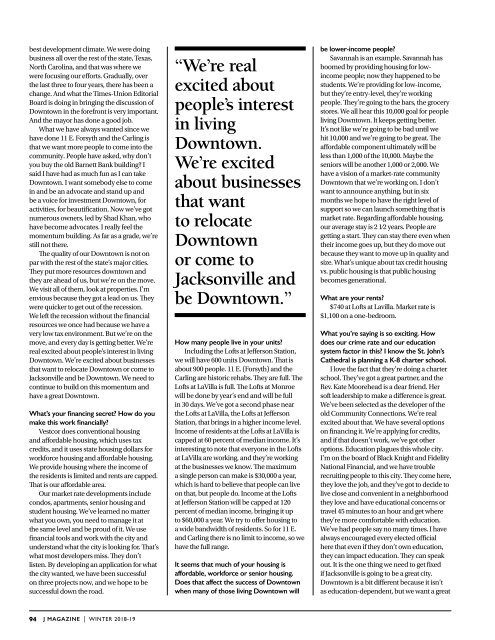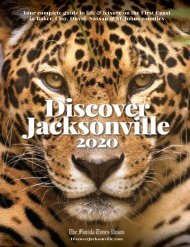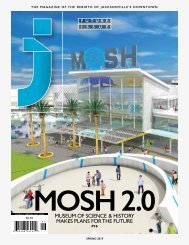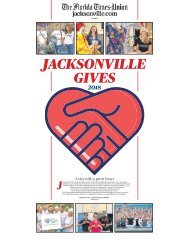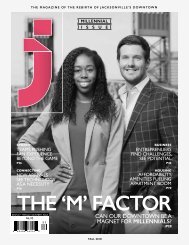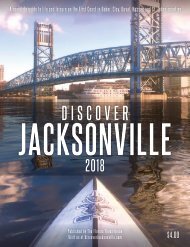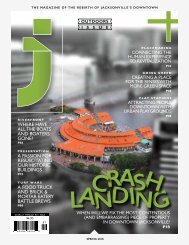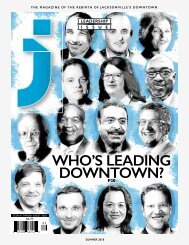J Magazine Winter 2018
You also want an ePaper? Increase the reach of your titles
YUMPU automatically turns print PDFs into web optimized ePapers that Google loves.
est development climate. We were doing<br />
business all over the rest of the state, Texas,<br />
North Carolina, and that was where we<br />
were focusing our efforts. Gradually, over<br />
the last three to four years, there has been a<br />
change. And what the Times-Union Editorial<br />
Board is doing in bringing the discussion of<br />
Downtown in the forefront is very important.<br />
And the mayor has done a good job.<br />
What we have always wanted since we<br />
have done 11 E. Forsyth and the Carling is<br />
that we want more people to come into the<br />
community. People have asked, why don’t<br />
you buy the old Barnett Bank building? I<br />
said I have had as much fun as I can take<br />
Downtown. I want somebody else to come<br />
in and be an advocate and stand up and<br />
be a voice for investment Downtown, for<br />
activities, for beautification. Now we’ve got<br />
numerous owners, led by Shad Khan, who<br />
have become advocates. I really feel the<br />
momentum building. As far as a grade, we’re<br />
still not there.<br />
The quality of our Downtown is not on<br />
par with the rest of the state’s major cities.<br />
They put more resources downtown and<br />
they are ahead of us, but we’re on the move.<br />
We visit all of them, look at properties. I’m<br />
envious because they got a lead on us. They<br />
were quicker to get out of the recession.<br />
We left the recession without the financial<br />
resources we once had because we have a<br />
very low tax environment. But we’re on the<br />
move, and every day is getting better. We’re<br />
real excited about people’s interest in living<br />
Downtown. We’re excited about businesses<br />
that want to relocate Downtown or come to<br />
Jacksonville and be Downtown. We need to<br />
continue to build on this momentum and<br />
have a great Downtown.<br />
What’s your financing secret? How do you<br />
make this work financially?<br />
Vestcor does conventional housing<br />
and affordable housing, which uses tax<br />
credits, and it uses state housing dollars for<br />
workforce housing and affordable housing.<br />
We provide housing where the income of<br />
the residents is limited and rents are capped.<br />
That is our affordable area.<br />
Our market rate developments include<br />
condos, apartments, senior housing and<br />
student housing. We’ve learned no matter<br />
what you own, you need to manage it at<br />
the same level and be proud of it. We use<br />
financial tools and work with the city and<br />
understand what the city is looking for. That’s<br />
what most developers miss. They don’t<br />
listen. By developing an application for what<br />
the city wanted, we have been successful<br />
on three projects now, and we hope to be<br />
successful down the road.<br />
“We’re real<br />
excited about<br />
people’s interest<br />
in living<br />
Downtown.<br />
We’re excited<br />
about businesses<br />
that want<br />
to relocate<br />
Downtown<br />
or come to<br />
Jacksonville and<br />
be Downtown.”<br />
How many people live in your units?<br />
Including the Lofts at Jefferson Station,<br />
we will have 600 units Downtown. That is<br />
about 900 people. 11 E. (Forsyth) and the<br />
Carling are historic rehabs. They are full. The<br />
Lofts at LaVilla is full. The Lofts at Monroe<br />
will be done by year’s end and will be full<br />
in 30 days. We’ve got a second phase near<br />
the Lofts at LaVilla, the Lofts at Jefferson<br />
Station, that brings in a higher income level.<br />
Income of residents at the Lofts at LaVilla is<br />
capped at 60 percent of median income. It’s<br />
interesting to note that everyone in the Lofts<br />
at LaVilla are working, and they’re working<br />
at the businesses we know. The maximum<br />
a single person can make is $30,000 a year,<br />
which is hard to believe that people can live<br />
on that, but people do. Income at the Lofts<br />
at Jefferson Station will be capped at 120<br />
percent of median income, bringing it up<br />
to $60,000 a year. We try to offer housing to<br />
a wide bandwidth of residents. So for 11 E.<br />
and Carling there is no limit to income, so we<br />
have the full range.<br />
It seems that much of your housing is<br />
affordable, workforce or senior housing.<br />
Does that affect the success of Downtown<br />
when many of those living Downtown will<br />
be lower-income people?<br />
Savannah is an example. Savannah has<br />
boomed by providing housing for lowincome<br />
people; now they happened to be<br />
students. We’re providing for low-income,<br />
but they’re entry-level, they’re working<br />
people. They’re going to the bars, the grocery<br />
stores. We all hear this 10,000 goal for people<br />
living Downtown. It keeps getting better.<br />
It’s not like we’re going to be bad until we<br />
hit 10,000 and we’re going to be great. The<br />
affordable component ultimately will be<br />
less than 1,000 of the 10,000. Maybe the<br />
seniors will be another 1,000 or 2,000. We<br />
have a vision of a market-rate community<br />
Downtown that we’re working on. I don’t<br />
want to announce anything, but in six<br />
months we hope to have the right level of<br />
support so we can launch something that is<br />
market rate. Regarding affordable housing,<br />
our average stay is 2 1⁄2 years. People are<br />
getting a start. They can stay there even when<br />
their income goes up, but they do move out<br />
because they want to move up in quality and<br />
size. What’s unique about tax credit housing<br />
vs. public housing is that public housing<br />
becomes generational.<br />
What are your rents?<br />
$740 at Lofts at Lavilla. Market rate is<br />
$1,100 on a one-bedroom.<br />
What you’re saying is so exciting. How<br />
does our crime rate and our education<br />
system factor in this? I know the St. John’s<br />
Cathedral is planning a K-8 charter school.<br />
I love the fact that they’re doing a charter<br />
school. They’ve got a great partner, and the<br />
Rev. Kate Moorehead is a dear friend. Her<br />
soft leadership to make a difference is great.<br />
We’ve been selected as the developer of the<br />
old Community Connections. We’re real<br />
excited about that. We have several options<br />
on financing it. We’re applying for credits,<br />
and if that doesn’t work, we’ve got other<br />
options. Education plagues this whole city.<br />
I’m on the board of Black Knight and Fidelity<br />
National Financial, and we have trouble<br />
recruiting people to this city. They come here,<br />
they love the job, and they’ve got to decide to<br />
live close and convenient in a neighborhood<br />
they love and have educational concerns or<br />
travel 45 minutes to an hour and get where<br />
they’re more comfortable with education.<br />
We’ve had people say no many times. I have<br />
always encouraged every elected official<br />
here that even if they don’t own education,<br />
they can impact education. They can speak<br />
out. It is the one thing we need to get fixed<br />
if Jacksonville is going to be a great city.<br />
Downtown is a bit different because it isn’t<br />
as education-dependent, but we want a great<br />
94<br />
J MAGAZINE | WINTER <strong>2018</strong>-19


